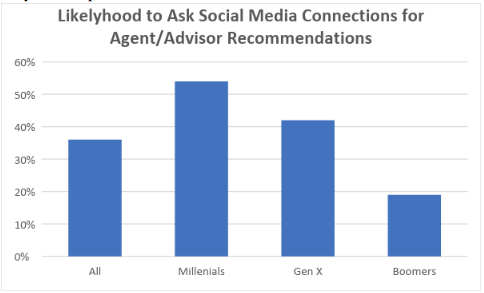How to Resuscitate Life Insurance
Companies can scrabble over a dwindling pie of revenue--or adapt and find themselves at the forefront of a new golden age of life insurance.

Companies can scrabble over a dwindling pie of revenue--or adapt and find themselves at the forefront of a new golden age of life insurance.

Get Involved
Our authors are what set Insurance Thought Leadership apart.
|
Partner with us
We’d love to talk to you about how we can improve your marketing ROI.
|

Tony Laudato joined the Hannover Re Group in July 2012 and is currently leading the partnership solutions group that supports insurance carriers’ products, web, mobile and digital strategies that are focused on the demands of today’s consumers and reaching new markets.

Now that we're a good couple of years into the fascination with the potential of blockchain, some breakthrough uses should be popping up, right? Instead, we're starting to see articles like this one from McKinsey that suggests scaling back ambitions, at least in the short run. What gives?
Some of the disappointment may be inevitable. We've all seen the hype curve and know that new technologies, especially ones with as much potential for fundamental change as blockchain, often produce massive expectations, only to then descend into the Slough of Despond for months or years, before reaching their destiny.
Some of the pushback comes because blockchain's limitations are becoming clear—it's computationally intensive enough that it's not well-suited to massive storage of information, for instance—and because alternative technologies can solve many of the problems that were initially assumed to be the province of blockchain.
But if you'll permit me a geeky analogy, harking back to my days covering the world of technology for the Wall Street Journal in the 1980s and 1990s, those driving adoption of blockchain are behaving too much like Unix and not enough like Linux.
Unix is a well-regarded operating system that became positively adored by almost every major computer company not named Microsoft. Windows had achieved a monopoly on all but the modest number of personal computers then sold by Apple. Companies needed a way to compete with Microsoft, so they rallied around Unix, a key version of which was in the public domain. The problem—and the lesson for the insurance industry—is that just about every company tweaked that version of Unix.
Something isn't really a standard, is it, if I have my version, you have yours and Sally down the street has another?
Eventually, people in the industry realized they were ceding the key advantage to Microsoft—any program written for Windows could run on any PC-compatible, while programs written for one version of Unix had to be revised before they could run fully on another version. So, the industry formed a consortium to produce a single "kernel" for Unix—and everyone tweaked that.
I can't even tell you how many presentations I sat through from IBM, HP, Sun, etc. about how their version of Unix was the best, or how little response I got when I argued that the fragmentation of the Unix effort was going to kill everybody's Unix and keep the market clear for Microsoft.
While insurance isn't showing the knuckleheadedness that I saw in the computer world in the '90s, there still is a lot of fragmentation in the efforts to develop blockchain technology. It's tempting to try to set the standard, because a company that sets the rules usually wins the game. There's a reason Bill Gates is still second on the Forbes list of richest people in the world even though he keeps giving his money away through his and his wife's foundation.
The industry would be much better off with a focused, joint effort to develop the core blockchain technology, at which point the competition could be how to build the best uses on top of that technology. This is what happened with Linux. When Linus Torvalds wrote the kernel and put it into the public domain in 1991, development became an open-source project for the entire coder community, not a series of one-off efforts by companies. Competition became about, for instance, developing the best tools for writing apps on top of that operating system, and there was plenty of profit there: Red Hat, for instance, recently agreed to be purchased by IBM for $34 billion. Not Bill Gates money, but I'd take it.
Look at how the telecommunications world collaborates on the standards for each new generation of Wi-Fi and how much business those new standards create. We'll all end up buying new phones once 5G rolls out; video and gaming companies will find new content and services to sell us; etc.
Blockchain will still have growing pains, but we as an industry can do better.
Cheers,
Paul Carroll
Editor-in-Chief
Get Involved
Our authors are what set Insurance Thought Leadership apart.
|
Partner with us
We’d love to talk to you about how we can improve your marketing ROI.
|

Paul Carroll is the editor-in-chief of Insurance Thought Leadership.
He is also co-author of A Brief History of a Perfect Future: Inventing the Future We Can Proudly Leave Our Kids by 2050 and Billion Dollar Lessons: What You Can Learn From the Most Inexcusable Business Failures of the Last 25 Years and the author of a best-seller on IBM, published in 1993.
Carroll spent 17 years at the Wall Street Journal as an editor and reporter; he was nominated twice for the Pulitzer Prize. He later was a finalist for a National Magazine Award.
CAT bonds are proving that they have some inherent advantages over collateralized reinsurance when included in ILS portfolios.

Get Involved
Our authors are what set Insurance Thought Leadership apart.
|
Partner with us
We’d love to talk to you about how we can improve your marketing ROI.
|

Pete Vloedman is a thought leader in reinsurance, insurance-linked securities and disaster financing. He has over 28 years of (re)insurance and asset management experience. Vloedman is currently a portfolio manager of Context Insurance Linked Income Fund (ILSIX).
In leadership – KEEP IT SIMPLE – speak in a common language and make certain that what is heard and what is said align.

Get Involved
Our authors are what set Insurance Thought Leadership apart.
|
Partner with us
We’d love to talk to you about how we can improve your marketing ROI.
|

Mike Manes was branded by Jack Burke as a “Cajun Philosopher.” He self-defines as a storyteller – “a guy with some brain tissue and much more scar tissue.” His organizational and life mantra is Carpe Mañana.
Machine learning is part of our everyday lives. Innovative insurers are now jumping on the ML wagon; which carriers will be left behind?

Get Involved
Our authors are what set Insurance Thought Leadership apart.
|
Partner with us
We’d love to talk to you about how we can improve your marketing ROI.
|

Oren Steinberg is an experienced CEO and entrepreneur with a demonstrated history of working in the big-data, digital-health and insurtech industries.
As innovation spreads across industries, the advent of tech-based economies is changing the very definition of risk.

Get Involved
Our authors are what set Insurance Thought Leadership apart.
|
Partner with us
We’d love to talk to you about how we can improve your marketing ROI.
|

Kirstin Marr is the executive vice president of data solutions at Insurity, a leading provider of cloud-based solutions and data analytics for the world’s largest insurers, brokers and MGAs.
Insurers must provide elite service, efficiency and innovation that meets the high expectations of small business customers on technology.

Get Involved
Our authors are what set Insurance Thought Leadership apart.
|
Partner with us
We’d love to talk to you about how we can improve your marketing ROI.
|

Mathew Stordy is senior director of commercial insurance for LexisNexis Risk Solutions. Stordy is responsible for driving the development of solutions for the commercial insurance market.
Predictive analytics helps insurance companies create customer profiles, prevent fraud and offer excellent pricing options based on risk hedging.

Get Involved
Our authors are what set Insurance Thought Leadership apart.
|
Partner with us
We’d love to talk to you about how we can improve your marketing ROI.
|

Emilia Marius is a senior business analyst/project manager. Combining eight-plus years of expertise in delivering data analytics solutions with three-plus years in project management, she has been leading both business intelligence and big data projects.
To address the life insurance gap among millennials and create more financial security, the industry needs to move quickly.

 Source: LIMRA 2018 Insurance Barometer[/caption]
Millennials expect service levels that the industry doesn’t provide
In today’s on-demand world, consumers want to research and compare products online, whenever and wherever they want. In fact, consumers are even willing to share data in return for products and services that make our lives easier, according to Accenture’s recent Global Financial Services Consumer Study. Millennials also want simpler, more intuitive solutions rather than the traditional, overly complex product suites, which the Morgan Stanley and the Boston Consulting Group report finds are not resonating with today’s consumers.
The insurance industry now has a tremendous opportunity to deliver customer-centric, personalized service levels to today’s savvy consumers. The prevalence of available online data underscores the opportunity insurers have to use data end to end – from engagement and lead gen through distribution and pre-approved “buy-up” options. In addition, emerging technologies such as artificial intelligence can be employed to improve workflows and other operational efficiencies, so insurers have more bandwidth to meet the growing demands of this market.
Millennials want to transact easily, wherever and whenever they want
Millennials typically don’t want brokers coming to their homes or requiring multiple appointments that have to be scheduled during work hours or when taking care of families. Millennials expect to be able to transact digitally and to get confirmation in near real time. This is not to say that human-to-human insurance distribution isn’t valuable.. It absolutely is. But the experience of transacting must ultimately be easy, or the buying experience can become tainted.
Transforming insurance distribution for the 21st century
There is no doubt that the transformation is happening. The insurance industry is redefining how products are delivered while ensuring they are driven by customer requirements and not outdated processes and products.
On the front end, user engagement is critical. Consumers want to research and find real answers at their convenience. Carriers, brokers and agents want to be visible when consumers are interested in insurance products. Yet simply reaching a new audience with a good marketing strategy is not enough. Truly enabling potential customers to maneuver seamlessly through personalized information and the application process is where successful client acquisition occurs.
See also: Digital Distribution in Life Insurance
Advanced analytics can help insurers optimize the buyer’s journey by providing data on where in the conversion process people may drop off or disengage, so changes can be made to improve outcomes. In addition, the right data also can help insurers find upsell opportunities within the existing customer base by understanding the details of current coverage, where they might be lacking and how to upgrade policies quickly and easily. Analytics are also important to the underwriting process by recognizing customer demographics and the associated policy characteristics, for example.
On the back end, seamless communication and functionality between carriers, brokers and consumers is critical in shaping the customer experience. Deloitte’s 2019 Insurance Industry Outlook notes that the ability to manage all tiers of the insurer, broker and prospective customer transaction in real time, with direct access to core underwriting metrics, has increased conversion from 70% to 90% in North America.
Today’s consumer is willing to share experiences and has extremely high expectations when dealing with businesses providing a service. When consumers are making important financial decisions such as committing to a life insurance policy, it’s important that all aspects of engagement and interactions get it right the first time, so the industry can reach underserved markets, secure new revenue streams and deliver financial security to more people around the world.
Source: LIMRA 2018 Insurance Barometer[/caption]
Millennials expect service levels that the industry doesn’t provide
In today’s on-demand world, consumers want to research and compare products online, whenever and wherever they want. In fact, consumers are even willing to share data in return for products and services that make our lives easier, according to Accenture’s recent Global Financial Services Consumer Study. Millennials also want simpler, more intuitive solutions rather than the traditional, overly complex product suites, which the Morgan Stanley and the Boston Consulting Group report finds are not resonating with today’s consumers.
The insurance industry now has a tremendous opportunity to deliver customer-centric, personalized service levels to today’s savvy consumers. The prevalence of available online data underscores the opportunity insurers have to use data end to end – from engagement and lead gen through distribution and pre-approved “buy-up” options. In addition, emerging technologies such as artificial intelligence can be employed to improve workflows and other operational efficiencies, so insurers have more bandwidth to meet the growing demands of this market.
Millennials want to transact easily, wherever and whenever they want
Millennials typically don’t want brokers coming to their homes or requiring multiple appointments that have to be scheduled during work hours or when taking care of families. Millennials expect to be able to transact digitally and to get confirmation in near real time. This is not to say that human-to-human insurance distribution isn’t valuable.. It absolutely is. But the experience of transacting must ultimately be easy, or the buying experience can become tainted.
Transforming insurance distribution for the 21st century
There is no doubt that the transformation is happening. The insurance industry is redefining how products are delivered while ensuring they are driven by customer requirements and not outdated processes and products.
On the front end, user engagement is critical. Consumers want to research and find real answers at their convenience. Carriers, brokers and agents want to be visible when consumers are interested in insurance products. Yet simply reaching a new audience with a good marketing strategy is not enough. Truly enabling potential customers to maneuver seamlessly through personalized information and the application process is where successful client acquisition occurs.
See also: Digital Distribution in Life Insurance
Advanced analytics can help insurers optimize the buyer’s journey by providing data on where in the conversion process people may drop off or disengage, so changes can be made to improve outcomes. In addition, the right data also can help insurers find upsell opportunities within the existing customer base by understanding the details of current coverage, where they might be lacking and how to upgrade policies quickly and easily. Analytics are also important to the underwriting process by recognizing customer demographics and the associated policy characteristics, for example.
On the back end, seamless communication and functionality between carriers, brokers and consumers is critical in shaping the customer experience. Deloitte’s 2019 Insurance Industry Outlook notes that the ability to manage all tiers of the insurer, broker and prospective customer transaction in real time, with direct access to core underwriting metrics, has increased conversion from 70% to 90% in North America.
Today’s consumer is willing to share experiences and has extremely high expectations when dealing with businesses providing a service. When consumers are making important financial decisions such as committing to a life insurance policy, it’s important that all aspects of engagement and interactions get it right the first time, so the industry can reach underserved markets, secure new revenue streams and deliver financial security to more people around the world.
Get Involved
Our authors are what set Insurance Thought Leadership apart.
|
Partner with us
We’d love to talk to you about how we can improve your marketing ROI.
|

Ian Jeffrey is the chief executive officer of Breathe Life, a provider of a unified distribution platform for the insurance industry.
Machines have not taken over, nor will they. They have just greatly improved the human element of the claims process.

Get Involved
Our authors are what set Insurance Thought Leadership apart.
|
Partner with us
We’d love to talk to you about how we can improve your marketing ROI.
|

Leo Corcoran, CEO of ClaimVantage, has been in the insurance software business for over 20 years. Since establishing ClaimVantage, Corcoran has worked closely with customers and prospects to discuss their claim management processes and curated a company that tackles many pain points within the industry.